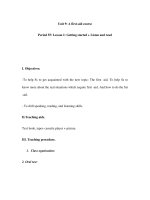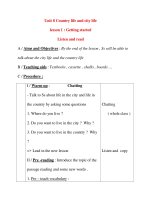Unit 4 Caring for those in need Lesson 1 Getting started
Bạn đang xem bản rút gọn của tài liệu. Xem và tải ngay bản đầy đủ của tài liệu tại đây (2.09 MB, 16 trang )
<span class='text_page_counter'>(1)</span>DONG KINH HIGH SCHOOL. WELCOME TO OUR CLASS. Designed by : Doan Thi Huong Thao.
<span class='text_page_counter'>(2)</span> Look at pictures and discuss the lesson topic.
<span class='text_page_counter'>(3)</span>
<span class='text_page_counter'>(4)</span>
<span class='text_page_counter'>(5)</span>
<span class='text_page_counter'>(6)</span> Watch this video clip.
<span class='text_page_counter'>(7)</span> Monday, October 30th 2017 UNIT 4. CARING FOR THOSE IN NEED. HELPING STUDENTS IN NEED HELPING STUDENTS. LESSON 1. GETTING STARTED. IN NEED.
<span class='text_page_counter'>(8)</span> Listen and read Mai: Hi, what’s up? Why are there so many boxes in the library? Maria: I’m preparing some Christmas gifts for secondary students with disabilities in the school we visited two months ago. These are students with various visual, hearing, physical and cognitive impairments. Mai: Cognitive impairments? Maria: That’s learning difficulties. Kevin: I have a neighbor who is blind, deaf and dumb, and needs a lot of help to get around. Maria: Well, you shouldn’t use words like “dumb” or “deaf”. It’s disrespectful. Mai: I agree. There are so many students with a disability who have talents and skills.. Maria: That’s right. And we need to help them to become independent, integrate in the community and achieve success at school. Mai: So what are these Christmas gifts? Maria: Last month, the Youth Union in our school had a meeting and decided to start a “Special Christmas Gifts” campaign to collect gifts for local charities. So far, the students in our school have donated more than 100 gifts. Mai: That’s great! Can students from other school join your campaign? Maria: Sure! A few other schools have already joined us. They have sent us textbooks, dictionaries, CD players, batteries…. Kevin: I have an idea for a gift! A talking pen for learning foreign languages. Maria: Great idea! What a meaningful gift! Mai: Thanks, Maria. I’ll talk to my classmates and what we can do..
<span class='text_page_counter'>(9)</span> VOCABULARY.
<span class='text_page_counter'>(10)</span> disability (n): disabled (a):. absent, or impaired physical or mental function (sự mất năng lưc/ sự tàn tật) handicapped (bị tàn tật). cognitive (a):. cognition (n) impairment. (n): impair (v) donate (v) sth. into sb/sth: integrate in. sth:. concerned with thinking or perceiving ( thuộc về nhận thức) a problem with body function and structure ( sự suy yếu/suy giảm) give (hiến tặng), tài trợ, quyên góp bring together and make whole (hội nhập).
<span class='text_page_counter'>(11)</span> disrespectful. (a): dumb (a):. rude (bất kính/ thô lỗ) , silent/cannot speak(bị câm). hard of hearing/cannot. deaf (a):. blind (a):. hear (bị điếc)- khiếm thính sightless (bị mù)-khiếm thị connected with seeing. visual (a):. (thuộc về mắt). Perceive(v). Nhận thức.
<span class='text_page_counter'>(12)</span> Talking about people with health issues top What you call something — or someone — matters. When writing or speaking about people with illnesses or disabilities, try not to use the condition to define them. That way you show that you know there’s a lot more to the person than just their illness or disability. So, instead of saying something like “the mentally disabled,” say, “people who have mental disabilities.” Here are some more examples Instead of. Use. The disabled; handicapped; crippled; lame; deformed. People with disabilities. The blind. People who are blind (or visually impaired). The deaf. People who are deaf. Confined to a wheelchair. Uses a wheelchair. Dumb; mute. Unable to speak. Is autistic. Has autism. Cerebral palsy victim. Person who has cerebral palsy.
<span class='text_page_counter'>(13)</span> 2. Decide whether the following statements are true (T), false (F), or not given (NG). Tick the correct box. T F NG 1. Maria is preparing some gifts for students with disabilities. 2. Only students at Maria’s school can join in the campaign. 3. Local charities will send the gifts to different schools. 4. Kevin will donate an educational toy for learning languages. 5. Maria will plan a visit to a school for children with disabilities.. .
<span class='text_page_counter'>(14)</span> 3. Let’s talk How do you think non- disabled people perceive and treat people with disabilities?. Treat a friend with a disability or illness just like you would any other friend. Your friend may want to talk about their condition; then again, your friend may not. You can let them know you care by telling them you will listen any time they feel like talking. If you’re meeting someone new, you may need to figure out how to act. You can ask the person if she wants any help and talk about the usual things you talk about with anyone new..
<span class='text_page_counter'>(15)</span> How 3. Let’s talkto. treat someone with a health issue top Before you give help, ask if the person needs it. The person may want to do. things for herself. It's okay to ask friends or classmates about their illnesses or disabilities. But don't be offended if your friend doesn't want to talk about it. Don't be afraid to ask questions if you are not sure how to act. Invite friends or classmates with illnesses or disabilities to sleepovers and birthday parties, and to hang out. Think about ways to make sure they can be included in the things you do. Ask your parents not to park in places reserved for people with disabilities. When you go to restaurants and shopping malls, check to see if a friend with an illness or disability could be there with you. If not, you can be a good friend by asking the manager to put in ramps, get raised numbers for the elevators, or have Braille menus printed. Kids with illnesses or disabilities can have it tough sometimes. Be friendly and welcoming to them. And if you see them being bullied, get help..
<span class='text_page_counter'>(16)</span>
<span class='text_page_counter'>(17)</span>









